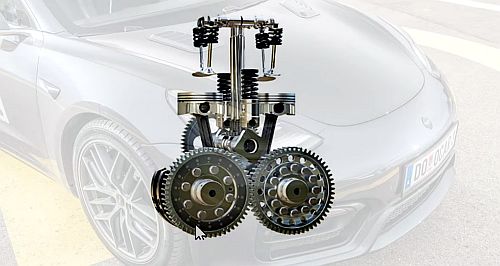Obrist develops high efficiency two-cyl hybrid

EFFORTS to refine the combustion engine in simpatico with climate change and make it more efficient are manifold with many different configurations under development using all sorts of fuel.
German/Austrian engineering group Obrist takes a slightly different tack on ICE with its so-called Champagne Engine, a tiny two-cylinder Zero Vibration Generator (ZVG) engine that is claimed to run smoother than a V12 – and is completely scalable.
Obrist came up with the champagne reference in relation to its creation because the tiny double lunger runs so smoothly that a filled champagne glass stands perfectly still on top of it.
They are using it as a linchpin for an in-house developed HyperHybrid drive system used in conjunction with an electric motor with refuelling like a combustion engine.
It is the same principle as used in diesel electric locomotives for decades and Nissan’s e-Power system in new Qashqai and X-Trail, but more compact and (claimed) efficient with the emphasis on compact.
Obrist Group recently took the bit between its teeth and demonstrated the twin-cylinder engine that is slated for use in a transport application including motorsport that, indeed, judging by YouTube videos, runs smoother than a twelve-cylinder which is considered the benchmark for refined operation in combustion engines.
The mini engine is not connected to the vehicle's drivetrain but is used solely for power generation feeding an electric motor that drives the vehicle via a compact buffer battery.
“HyperHybrid combines the advantages of electric mobility with the simplicity of the familiar refuelling process, thereby solving the problem of range anxiety that is inherently associated with electric cars,” said Obrist Group founder Frank Obrist.
Mr Obrist has been involved in developing the HyperHybrid concept with his team since 2011 arriving at a vehicle that runs on conventional fuel (petrol or e-fuels) from any service station.
He says fuel consumption is very low at around 1.5 litres per 100km, and the range (without refuelling or recharging) is over 1000km – both numbers far exceeding the capabilities of Nissan’s e-Power hybrid.
“Therefore, unlike pure electric mobility, this hybrid does not require a new charging infrastructure,” he added.
“It also eliminates the need for the large and heavy battery packs required for electric cars, and the significant environmental impact inevitably associated with their production.”
The core components of the HyperHybrid are its ZVG and buffer battery, and because the 45kW and 110kg Champagne Engine is used only to recharge the vehicle’s buffer battery and power the air conditioning when needed, it does not need to rev up like a conventional car engine.
“Instead, it always runs in the optimum rev range, if at all,” added Mr Obrist.
“The engine’s design principle is deliberately simple: technically, it is a 1.0-litre naturally aspirated engine with multi-channel fuel injection. There is no need for variable valve timing, which is common in drive engines.”
The clever part of the engine are its two crankshafts that operate in opposite directions, countering any vibrations.
A rubber-damper on the second crankshaft minimises noise generated by the gearbox. An integrated flywheel compensates for all the inertias of the rotating parts, including external forces outside the engine, such as the oil system with the oil pump.
As a result, and with complete encapsulation in a soundproofing box approximately the size of a shoebox, the engine operates virtually noiselessly and vibration-free.
The compact buffer battery pack consists of two layers of stacked cylindrical cells in a vacuum maintained by an integrated pump within the battery.
A 20mm thick insulating layer ensures consistently favourable temperature conditions and the entire mini-battery weighs 98kg or about 85 per cent less than the battery block in a Tesla Model Y.
With 17.3kWh it provides the HyperHybrid system with a purely electric range of over 80km, enough says Mr Obrist for 90 per cent of everyday trips.
According to a statement from the company, the HyperHybrid system is production-ready and is considered as an alternative to purely battery-electric mobility.
“While the Champagne Engine installed in the vehicle does produce carbon dioxide when operated with gasoline, it generates very little due to its low consumption,” continued Mr Obrist.
“In contrast, the so-called ‘CO2 backpack’ of conventional electric cars – the CO2 burden associated with the production of large battery blocks – is almost eliminated with the HyperHybrid.”
If the Champagne Engine is powered by sustainably produced e-fuels, the CO2 balance actually reverses: the production of the synthetic fuel can remove more CO2 from the atmosphere than is released during its later combustion in the mini engine.
The Obrist Group refers to this as a ‘CO2-negative’ or ‘climate-positive’ approach adding that the HyperHybrid concept has good prospects for use in Europe, provided that the planned ban on internal combustion vehicles in 2035 includes an exemption for cars running on e-fuels.